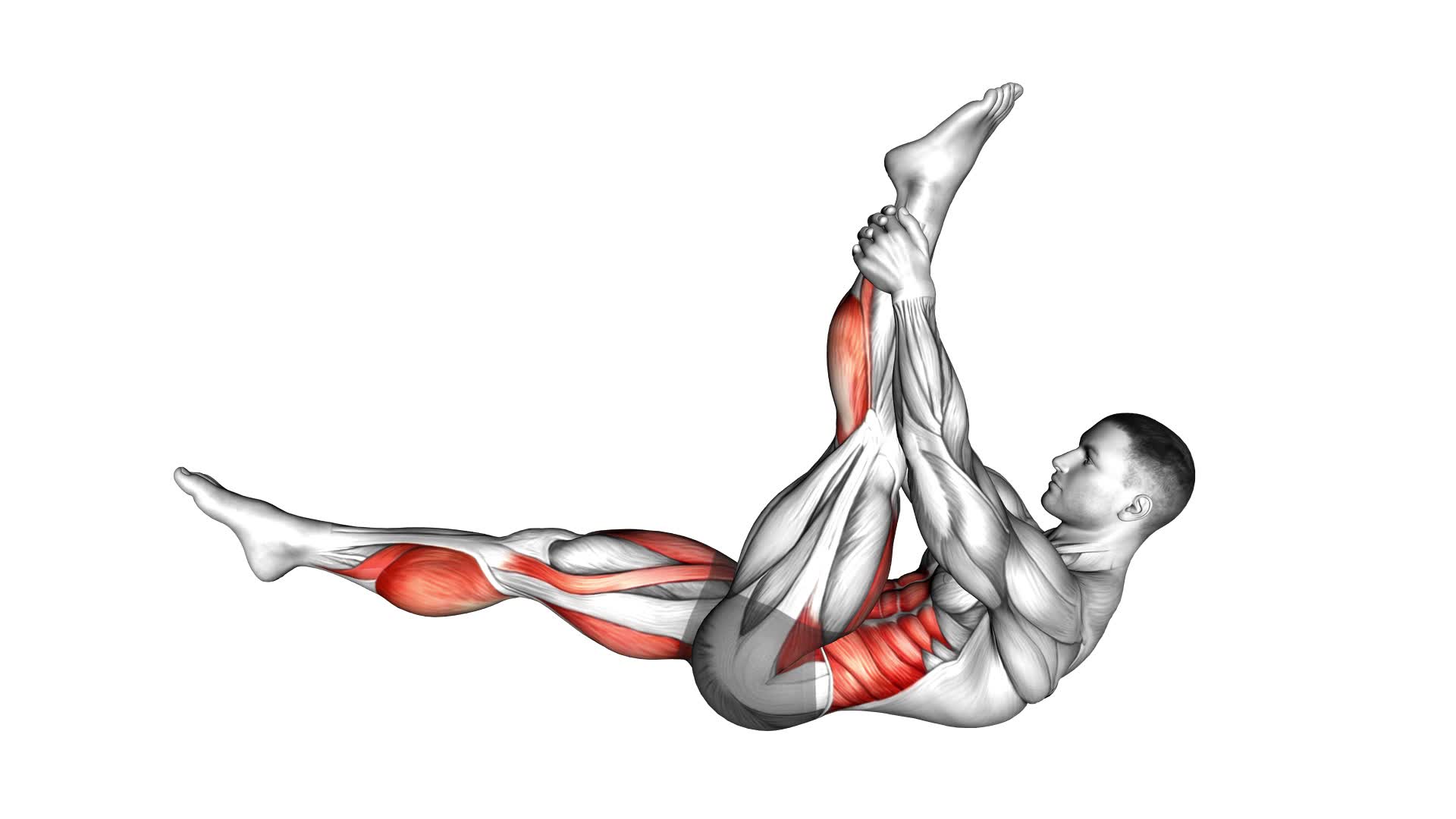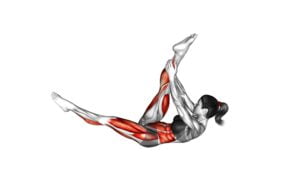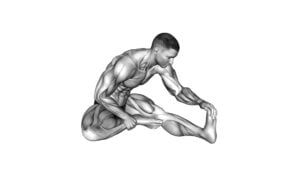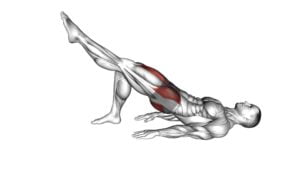Single Straight Leg Stretch (male) – Video Exercise Guide & Tips

In this video exercise guide, you'll learn how to perform the Single Straight Leg Stretch, specifically tailored for men.
Watch This Exercise Video
This exercise offers a range of benefits, including strengthening your core, improving flexibility, and toning your legs.
You'll discover proper form and technique, as well as modifications for beginners and advanced variations for those seeking a challenge.
Avoid common mistakes and maximize the effectiveness of this exercise with our helpful tips.
Let's get started!
Key Takeaways
- The Single Straight Leg Stretch is beneficial for strengthening core muscles, improving flexibility, toning legs, enhancing posture, and increasing stability.
- Proper form and technique include using controlled and smooth motion, engaging core muscles, avoiding swinging legs with momentum, and keeping the lower back on the mat.
- Beginners can modify the exercise by bending knees slightly, using a strap or towel for support, placing hands behind thighs, performing fewer repetitions, and gradually increasing intensity.
- Advanced variations and progressions of the Single Straight Leg Stretch include weighted versions, adding twists, pulsing movements, incorporating single leg pike stretches, and dynamic exercises for overall body strength and mobility.
Benefits of the Single Straight Leg Stretch
What are the benefits of the Single Straight Leg Stretch for you?
The Single Straight Leg Stretch is a Pilates exercise that offers numerous benefits for your body and overall well-being. This exercise primarily targets your abdominal muscles, helping to strengthen and tone them. By engaging your core, the Single Straight Leg Stretch also improves your posture and stability.
In addition to targeting your abs, this exercise also works your hip flexors, hamstrings, and quadriceps. As you extend one leg at a time, you lengthen and strengthen these muscles. This can improve your flexibility and range of motion, making everyday movements easier and reducing the risk of injury.
The Single Straight Leg Stretch also engages your deep stabilizing muscles, such as the transverse abdominis and pelvic floor muscles. Strengthening these muscles can enhance your overall core strength and stability, which is crucial for maintaining good balance and preventing lower back pain.
To perform the Single Straight Leg Stretch, lie on your back with your legs extended towards the ceiling. Keep your core engaged as you lower one leg towards the floor, maintaining control and avoiding any arching in your lower back. Alternate legs in a smooth and controlled manner, focusing on engaging your core throughout the movement.
Proper Form and Technique
To perform the Single Straight Leg Stretch with proper form and technique, ensure you use a controlled and smooth motion while engaging your core. This exercise primarily targets the abdominal muscles, but it also works the hip flexors, hamstrings, and lower back. To maximize effectiveness, it's important to avoid common mistakes such as using momentum to swing your legs or allowing your lower back to lift off the mat.
Start by lying on your back with your legs extended and your arms by your sides. Inhale to prepare, then exhale as you engage your core and lift your head, neck, and shoulders off the mat. Keep your gaze towards your belly button and your chin slightly tucked.
Inhale to maintain this position as you lift one leg towards the ceiling, keeping it straight and the opposite leg grounded. Exhale as you lower the lifted leg towards the mat, maintaining control and avoiding any unnecessary movements. Repeat on the other side, alternating legs for the desired number of repetitions.
Remember to maintain proper form throughout the exercise, focusing on the engagement of your core and the controlled movement of your legs. By following these guidelines, you'll maximize the effectiveness of the Single Straight Leg Stretch and ensure that you're targeting the intended muscle groups.
Modifications for Beginners
If you're a beginner looking for easier modification options for the Single Straight Leg Stretch exercise, there are a few adjustments you can make to make it more accessible.
- One option is to bend your knees slightly instead of keeping your legs straight. This will reduce the intensity and allow you to focus on engaging your core muscles.
- Another progression for beginners is to use a strap or towel to hold onto your legs instead of reaching for your ankles. This provides extra support and stability as you work on building strength and flexibility.
Easier Modification Options
To make the Single Straight Leg Stretch exercise easier for beginners, you can try using a modification option. Here are some easier modifications that you can consider:
- Bend your knees slightly: Instead of keeping your legs straight, you can bend your knees slightly to reduce the intensity of the stretch. This modification will still engage your core muscles but with less strain on your lower back.
- Use a resistance band: Wrap a resistance band around your feet and hold onto the ends to provide some assistance during the exercise. The band will help you maintain control and stability, making it easier to perform the movement.
- Place your hands behind your thighs: Instead of reaching for your ankles, you can place your hands behind your thighs. This modification provides additional support and stability, allowing you to focus on engaging your core muscles without straining your neck or shoulders.
Progression for Beginners
Start by incorporating modifications that are suitable for beginners to progress in the Single Straight Leg Stretch exercise.
As a beginner, it's important to start out with techniques that allow you to build strength and flexibility gradually.
One modification you can try is bending your knees slightly instead of keeping your legs straight. This will reduce the intensity of the exercise and make it more manageable for beginners.
Another modification is to keep your hands behind your head for added support, instead of reaching for your ankles. This will help you maintain proper form and prevent strain on your neck and shoulders.
Additionally, you can start by performing fewer repetitions and gradually increase the number as you become more comfortable with the exercise.
Advanced Variations and Progressions
Ready to take your Single Straight Leg Stretch to the next level?
Advanced variations and progressions are designed to challenge even the most experienced practitioners.
These modifications will help you build strength and flexibility, pushing your practice further and allowing you to achieve new levels of fitness.
Get ready to step up your game and see how far you can go with this advanced variation.
Challenging Modifications for Advanced Practitioners
Master the Single Straight Leg Stretch with these advanced variations and progressions to take your practice to the next level. Here are some challenging modifications for advanced practitioners:
- Weighted Single Straight Leg Stretch: Hold a dumbbell or kettlebell in your hands as you perform the exercise to increase resistance and challenge your core muscles even more.
- Single Straight Leg Stretch with Twist: Add a rotational component to the exercise by twisting your upper body to the side as you extend your leg, engaging your obliques and enhancing core strength and stability.
- Pulsing Single Straight Leg Stretch: Instead of holding the leg extension, perform small pulses at the end range of motion to intensify the burn in your abs and increase muscular endurance.
These advanced modifications and techniques will push you to new limits, helping you build a stronger, more resilient core. Remember to maintain proper form and listen to your body to prevent injury.
Building Strength and Flexibility
To build strength and flexibility with advanced variations and progressions, challenge yourself with these dynamic exercises. These exercises are designed to increase mobility and prevent injuries by targeting specific muscle groups and improving overall body strength.
One advanced variation is the Single Leg Pike Stretch. Start by lying on your back with both legs extended. Lift one leg straight up towards the ceiling, keeping the other leg extended on the ground. Reach towards your lifted leg with both hands, engaging your core and stretching your hamstrings and lower back.
Another progression is the Standing Split. Begin in a standing position, then lift one leg straight up in front of you, keeping it as straight as possible. Reach towards your lifted leg with both hands, feeling a deep stretch in your hamstrings and hips.
These exercises will challenge your body and help you achieve greater strength and flexibility.
Taking Your Practice Further
To further advance your practice, try incorporating more challenging variations and progressions into your routine. This will help you continue to build strength and flexibility while keeping your practice fresh and exciting. Here are three ways you can take your Single Straight Leg Stretch to the next level:
- Exploring New Variations:
- Try performing the exercise with ankle weights to increase resistance and deepen the challenge.
- Experiment with different arm positions, such as reaching your arms overhead or extending them straight out in front of you.
- Incorporate rotational movements by twisting your torso to the side as you extend your leg.
- Incorporating Props:
- Use a resistance band around your feet to add extra tension and engage your leg muscles even more.
- Place a small stability ball between your ankles to work on your inner thigh strength and stability.
- Use a Pilates ring or magic circle to provide resistance and intensify the exercise.
By exploring new variations and incorporating props, you can continue to challenge yourself and progress in your practice.
Now, let's move on to the next section and learn about common mistakes to avoid.
Common Mistakes to Avoid
Avoiding these common mistakes will help you perform the Single Straight Leg Stretch exercise correctly and effectively. One of the most common mistakes people make isn't maintaining proper form. It's important to keep your core engaged and your lower back pressed into the mat throughout the entire exercise. This will ensure that you're targeting the right muscles and avoiding any strain on your lower back.
Another common mistake isn't keeping your legs straight. As you extend your leg out in front of you, make sure to keep it fully straightened and engaged. Avoid bending your knee or letting your leg droop down towards the ground. This will maximize the effectiveness of the exercise and prevent any unnecessary strain on your muscles.
It's also important to avoid rushing through the exercise. Take your time and focus on the quality of each movement. This will allow you to fully engage your muscles and get the most out of the exercise. Remember to breathe deeply and maintain a steady rhythm throughout.
Lastly, be mindful of your neck and shoulders. Avoid tensing up or straining these areas. Keep your shoulders relaxed and your neck in a neutral position. This will help prevent any unnecessary tension and allow you to focus on engaging your core and leg muscles.
Tips for Maximizing the Effectiveness
How can you enhance the effectiveness of the Single Straight Leg Stretch exercise? Maximizing the results of this exercise can be achieved by following a few simple tips:
- Maintain proper form: Ensure that your back is flat on the mat and your core is engaged throughout the movement. This will help target your abdominal muscles more effectively.
- Focus on the breath: Inhale deeply as you prepare for the movement and exhale fully as you extend your leg. This will help engage your deep core muscles and enhance the effectiveness of the exercise.
- Control the movement: Avoid using momentum or jerky movements. Instead, focus on slow and controlled movements, both when extending and bending your leg. This will engage your muscles more effectively and prevent injury.
By following these tips, you can maximize the effectiveness of the Single Straight Leg Stretch exercise and achieve better results.
Avoiding common mistakes such as poor form, shallow breathing, and using momentum will help you target your abdominal muscles more effectively and prevent injury. Remember to listen to your body and adjust the intensity of the exercise to suit your fitness level.
Frequently Asked Questions
How Many Calories Can I Burn by Doing the Single Straight Leg Stretch?
You can burn a significant amount of calories by doing the single straight leg stretch.
This exercise engages multiple muscle groups, increasing your heart rate and boosting your metabolism.
The more effort you put into the exercise, the more calories you'll burn.
To maximize calorie burning, focus on maintaining proper form and perform the exercise at a challenging intensity.
Can I Do the Single Straight Leg Stretch if I Have a Lower Back Injury?
If you have a lower back injury, it's important to modify the single straight leg stretch to avoid further harm. Instead of lifting both legs off the ground, keep one foot on the floor while extending the other leg. This reduces strain on your lower back.
Additionally, there are other exercises you can do to strengthen your lower back without risking injury, such as bird dogs, bridges, and pelvic tilts. These exercises can help improve stability and alleviate pain.
How Often Should I Perform the Single Straight Leg Stretch to See Results?
To see optimal results from the single straight leg stretch, it's important to consider the frequency of your workouts. How often you perform this exercise can greatly impact your progress.
Additionally, in order to continuously improve and challenge yourself, it's essential to know how to progress in the single straight leg stretch. By following a consistent routine and gradually increasing the difficulty of the exercise, you can achieve continuous improvement and see the desired results.
What Muscles Does the Single Straight Leg Stretch Target?
The single straight leg stretch targets several muscles in your body. It primarily focuses on your hamstrings, which are the muscles located at the back of your thighs. This exercise helps improve hamstring flexibility, allowing you to achieve a greater range of motion.
There are also variations of the single straight leg stretch that can target other muscles such as your core and hip flexors. Incorporating these variations can add more challenge and variety to your workout routine.
Is It Necessary to Warm up Before Doing the Single Straight Leg Stretch?
Before doing the single straight leg stretch, it's important to warm up your body.
Incorporating dynamic stretches before this exercise can provide several benefits. It helps increase blood flow to your muscles, improves flexibility, and reduces the risk of injury.
If you have limited flexibility, there are modifications and alternatives available for the single straight leg stretch. These modifications can help you perform the exercise safely and effectively, ensuring that you still get the desired benefits.
Conclusion
In conclusion, the single straight leg stretch is a highly effective exercise for strengthening the abdominal muscles and improving flexibility.
By maintaining proper form and technique, beginners can gradually increase the difficulty level and progress to advanced variations.
It's important to avoid common mistakes and follow the tips provided to maximize the effectiveness of this exercise.
Incorporating the single straight leg stretch into your workout routine can bring significant benefits to your overall fitness and wellness.

Author
Years ago, the spark of my life’s passion ignited in my mind the moment I stepped into the local gym for the first time. The inaugural bead of perspiration, the initial endeavor, the very first surge of endorphins, and a sense of pride that washed over me post-workout marked the beginning of my deep-seated interest in strength sports, fitness, and sports nutrition. This very curiosity blossomed rapidly into a profound fascination, propelling me to earn a Master’s degree in Physical Education from the Academy of Physical Education in Krakow, followed by a Sports Manager diploma from the Jagiellonian University. My journey of growth led me to gain more specialized qualifications, such as being a certified personal trainer with a focus on sports dietetics, a lifeguard, and an instructor for wellness and corrective gymnastics. Theoretical knowledge paired seamlessly with practical experience, reinforcing my belief that the transformation of individuals under my guidance was also a reflection of my personal growth. This belief holds true even today. Each day, I strive to push the boundaries and explore new realms. These realms gently elevate me to greater heights. The unique combination of passion for my field and the continuous quest for growth fuels my drive to break new ground.







